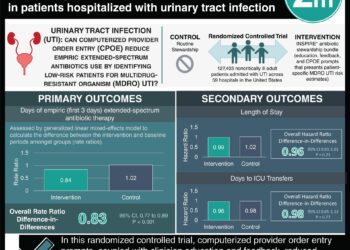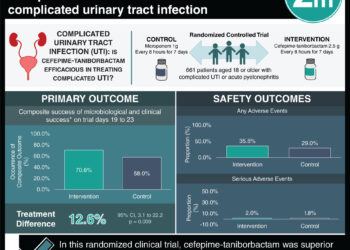Management of uncomplicated urinary tract infections amongst women in the United States Military Health System highly concordant with guidelines
1. The concordance rate with guidelines from the Infectious Disease Society of America was 91.0% amongst women with uncomplicated urinary tract infections and universal insurance coverage.
2. Concordance rates were higher amongst internal medicine, surgery, and emergency medicine practices, and lower in urology and obstetrics and gynecology.
Level of Evidence Rating: 2 (Good)
Study Rundown: Urinary tract infections (UTIs) are a leading cause of antibiotic prescriptions and the most common infectious disease amongst the United States population. In particular, females are susceptible to UTIs which are commonly uncomplicated, and resolve with a short course of antibiotic therapy. The Infectious Disease Society of America (IDSA) published guidelines in 2011 for the management of acute, uncomplicated cystitis amongst premenopausal women considering rising rates of antimicrobial resistance. The present study sought to describe rates of adherence to recommended antibiotic regimens for acute cystitis amongst a group of universally insured women in the United States.
In total, 46,793 women were included. Most patients were aged 18-34 (47.3%), White (38.2%) and had only one episode of acute cystitis during the study period (85.9%). 91.0% of patients received guideline-concordant antimicrobial therapy. The guideline concordance rate was higher in direct-care settings compared to the private sector. Primary care and emergency medicine physicians were most likely to diagnose acute cystitis amongst cases where the physician specialty data was identifiable. Antimicrobial prescriptions by Urologists and Obstetrician/Gynecologists were less frequently guideline-concordant, whereas all other specialties were more likely to follow IDSA guidelines. Overtreatment (defined as two or more antimicrobial agents) was most likely amongst emergency medicine and primary care physicians; the overall rate of overtreatment was 5.9%.
This study by Kikuchi et al identified a high rate of overall adherence to the IDSA guidelines for management of acute, uncomplicated cystitis amongst premenopausal women in the United States. These results are encouraging as they indicate the efforts being made to reduce the risk of antibiotic resistance through conscientious prescribing practices. A major strength of this study was the large sample size, which adequately powered conclusions about trends in antibiotic prescribing. However, a drawback of this work is the lack of granular data, limited by the retrospective nature of this study. For example, no information about the reasons for non-adherence to IDSA guidelines was available, limiting the clinical relevance of these results.
Click here to read this study in JAMA Network Open
Relevant reading: Acute uncomplicated cystitis in an era of increasing antibiotic resistance: a proposed approach to empirical therapy
In Depth [cross-sectional study]: A retrospective, cross-sectional study of cystitis treatment patterns amongst the Military Health System (MHS) was completed. All female beneficiaries of MHS health insurance aged 18-50 who had been treated for acute, uncomplicated cystitis between October 2017 and September 2019 were included. Only initial presentations of acute cystitis were included; this was assessed using the first international classification of disease code (ICD) N39.0 for each patient. IDSA concordance was defined as prescription of any one of the following first-line recommended antimicrobials: nitrofurantoin, trimethoprim-sulfamethoxazole, fosfomycin or pivmecillinam. Patients with ICD codes representing a complicated course of cystitis (i.e., pregnancy, pyelonephritis, diabetes, organ transplant recipients, human immunodeficiency virus, immunosuppression, renal insufficiency, urinary tract abnormalities or history of urologic procedures) were excluded.
The overall rate of guideline concordance for antimicrobial prescription amongst this population was 91.0%. The rate was 92.5% in direct-care settings and slightly lower (89.0%) in the private sector. In direct-care settings, 34.2% of UTIs were diagnosed by physicians with ‘unknown’ specialty, 23.3% by primary care physicians and 18.9% by emergency doctors. In the private sector these rates by specialty were 32.9%, 25.3% and 14.9%, respectively. Using guideline concordance rates from obstetrics/gynecology as a comparator, urology had a lower rate of guideline concordance (adjusted odds ratio [aOR] 0.40, 95% confidence interval 0.38-0.43). Other specialties were at higher odds of guideline concordance as follows: internal medicine (2.87, 3.73-3.03), family medicine (1.81, 1.76-1.87), surgery (1.51, 1.36-1.67) and emergency medicine (1.36, 1.32-1.39). The adjusted odds ratio for overtreatment was 3.78 (3.55-4.01) amongst emergency medicine physicians and 3.50 (3.28-3.74) amongst primary care physicians in comparison to obstetrics/gynecology.
Image: PD
©2022 2 Minute Medicine, Inc. All rights reserved. No works may be reproduced without expressed written consent from 2 Minute Medicine, Inc. Inquire about licensing here. No article should be construed as medical advice and is not intended as such by the authors or by 2 Minute Medicine, Inc.





![Carbon nanotubes ameliorate methamphetamine addiction in mice [PreClinical]](https://www.2minutemedicine.com/wp-content/uploads/2016/03/Blue_Crystal_Meth-75x75.jpg)

![The ABCD2 score: Risk of stroke after Transient Ischemic Attack (TIA) [Classics Series]](https://www.2minutemedicine.com/wp-content/uploads/2013/05/web-cover-classics-with-logo-medicine-BW-small-jpg-75x75.jpg)